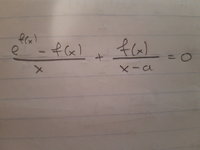Hey guys
The exercise in which I'm facing a problem is the following:
f(x)= 1/x ,x<0
ln(e^x+x) ,x<=0
It asks you to show that for every value of a>0 ,the equation
(e^f(x)-f(x))/x +f(x)/(x-a)=0
has at least one solution. My problem is that the function is not continuous at 0 so any theorem i can think of doesn't work. Any idea?
Thanks in advance
The exercise in which I'm facing a problem is the following:
f(x)= 1/x ,x<0
ln(e^x+x) ,x<=0
It asks you to show that for every value of a>0 ,the equation
(e^f(x)-f(x))/x +f(x)/(x-a)=0
has at least one solution. My problem is that the function is not continuous at 0 so any theorem i can think of doesn't work. Any idea?
Thanks in advance
Last edited:

